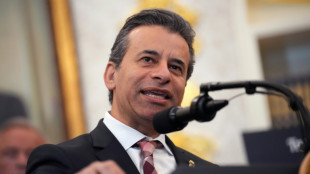
-
 UN warns of rough winter ahead for refugees
UN warns of rough winter ahead for refugees
-
Brazil's 'action agenda' at COP30 takes shape

-
 Trump threatens $1 billion action as BBC apologises for edit error
Trump threatens $1 billion action as BBC apologises for edit error
-
Sinner dominates injury-hit Auger-Aliassime in ATP Finals opener

-
 Trump hails Syria's 'tough' ex-jihadist president after historic talks
Trump hails Syria's 'tough' ex-jihadist president after historic talks
-
Syria's ex-jihadist president meets Trump for historic talks

-
 Top US court hears case of Rastafarian whose hair was cut in prison
Top US court hears case of Rastafarian whose hair was cut in prison
-
US mediator Kushner and Netanyahu discuss phase two of Gaza truce

-
 End to US government shutdown in sight as Democrats quarrel
End to US government shutdown in sight as Democrats quarrel
-
Trump threatens air traffic controllers over shutdown absences

-
 US to remove warnings from menopause hormone therapy
US to remove warnings from menopause hormone therapy
-
UK water firm says 'highly likely' behind plastic pellet pollution incident

-
 Syria's ex-jihadist president holds historic Trump talks
Syria's ex-jihadist president holds historic Trump talks
-
End to record-long US government shutdown in sight

-
 France's ex-leader Sarkozy says after jail release 'truth will prevail'
France's ex-leader Sarkozy says after jail release 'truth will prevail'
-
Atalanta sack coach Juric after poor start to season

-
 Trump threatens $1 billion action as BBC apologises for speech edit
Trump threatens $1 billion action as BBC apologises for speech edit
-
Gattuso wants 'maximum commitment' as Italy's World Cup bid on the line

-
 Indian capital car blast kills at least eight
Indian capital car blast kills at least eight
-
Deadly measles surge sees Canada lose eradicated status

-
 Brazil's Lula urges 'defeat' of climate deniers as COP30 opens
Brazil's Lula urges 'defeat' of climate deniers as COP30 opens
-
Strangled by jihadist blockade, Malians flee their desert town

-
 US Supreme Court declines to hear case challenging same-sex marriage
US Supreme Court declines to hear case challenging same-sex marriage
-
'Fired-up' Fritz sees off Musetti in ATP Finals

-
 Injured Courtois set to miss Belgium World Cup qualifiers
Injured Courtois set to miss Belgium World Cup qualifiers
-
Bulatov, pillar of Russian contemporary art scene, dies at 92

-
 Fritz sees off Musetti in ATP Finals
Fritz sees off Musetti in ATP Finals
-
US strikes on alleged drug boats kill six more people

-
 Sarkozy released from jail 'nightmare' pending appeal trial
Sarkozy released from jail 'nightmare' pending appeal trial
-
COP30 has a mascot: the fiery-haired guardian of Brazil's forest

-
 The Sudanese who told the world what happened in El-Fasher
The Sudanese who told the world what happened in El-Fasher
-
Three things we learned from the Sao Paulo Grand Prix

-
 ASC acquire majority share in Atletico Madrid
ASC acquire majority share in Atletico Madrid
-
Ferrari boss tells Hamilton, Leclerc to drive, not talk

-
 Bank of England seeks to 'build trust' in stablecoins
Bank of England seeks to 'build trust' in stablecoins
-
China suspends 'special port fees' on US vessels for one year

-
 French court frees ex-president Sarkozy from jail pending appeal
French court frees ex-president Sarkozy from jail pending appeal
-
No link between paracetamol and autism, major review finds

-
 Typhoon Fung-wong floods Philippine towns, leaves 5 dead in its wake
Typhoon Fung-wong floods Philippine towns, leaves 5 dead in its wake
-
France's Sarkozy says prison a 'nightmare' as prosecutors seek his release

-
 Guinness maker Diageo picks new CEO after US tariffs cloud
Guinness maker Diageo picks new CEO after US tariffs cloud
-
China suspends 'special port fees' on US vessels

-
 US senators take major step toward ending record shutdown
US senators take major step toward ending record shutdown
-
Typhoon Fung-wong leaves flooded Philippine towns in its wake

-
 From Club Med to Beverly Hills: Assinie, the Ivorian Riviera
From Club Med to Beverly Hills: Assinie, the Ivorian Riviera
-
The 'ordinary' Arnie? Glen Powell reboots 'The Running Man'

-
 Typhoon exposes centuries-old shipwreck off Vietnam port
Typhoon exposes centuries-old shipwreck off Vietnam port
-
French court to decide if ex-president Sarkozy can leave jail

-
 China lifts sanctions on US units of South Korea ship giant Hanwha
China lifts sanctions on US units of South Korea ship giant Hanwha
-
Japan death row inmate's sister still fighting, even after release


US launches satellite to better prepare for space weather
The United States on Tuesday launched a new satellite expected to significantly improve forecasts of solar flares and coronal mass ejections -- huge plasma bubbles that can crash into Earth, disrupting power grids and communications.
A SpaceX Falcon Heavy rocket carrying the satellite into orbit took off from NASA's Kennedy Space Center in Florida at 5:26 pm (2126 GMT), the US space agency announced.
The GOES-U (Geostationary Operational Environmental Satellite U) mission is a collaboration between NASA and the National Oceanic and Atmospheric Administration (NOAA).
It will be the fourth and final in a series of satellites that have tracked hurricanes and tornadoes, monitored climate and sea surface temperature, air quality and even meteor detections since 2016.
Orbiting 22,236 miles (35,785 kilometers) above the equator, the satellites match the speed of Earth's rotation in order to hold their positions over specific regions and provide continuous coverage.
They "are an indispensable tool for protecting the United States and the one billion people who live and work in the Americas," NOAA's Pam Sullivan told a press conference.
GOES-U is the first of the four to include a coronagraph, called the Compact Coronagraph-1 (CCOR-1). Coronagraphs block the Sun's disk and allow observation of its outermost layer, called the corona.
"That allows us to observe large explosions off the sun, called coronal mass ejections that can hurtle billions of tons of matter at millions of miles per hour towards Earth," said Elsayed Talaat, in charge of space weather observations at NOAA.
The ejections, known as CMEs, can disrupt Earth's magnetic field, causing satellites, energy infrastructure, and navigation systems to go down. Collecting space weather data allows authorities to issue warnings one to four days in advance.
In early May, the planet experienced its first level 5 geomagnetic storm in two decades, the highest rating on the scale, which unleashed spectacular auroras worldwide.
With the new coronagraph, the speed and direction of this event could have been better understood from the start, said Talaat.
Major disruptions weren't felt, but some farmers "reported being unable to plant their crops because the precision GPS relied upon by their equipment had malfunctioned," he said.
For the first time, the United States will have a coronagraph observing the solar corona almost continuously, with the CCOR-1 taking readings every 30 minutes.
Currently, such observations are received with a delay of up to eight hours. They are carried out by a satellite launched in 1995, which should cease operating within two years.
"Once operational CCOR-1 will mark a new chapter in space weather observations," said Talaat.
"Although the sun is no more active than in previous generations, our society has changed, and we are more sensitive than ever to the sun's changing mood."
O.Karlsson--AMWN



